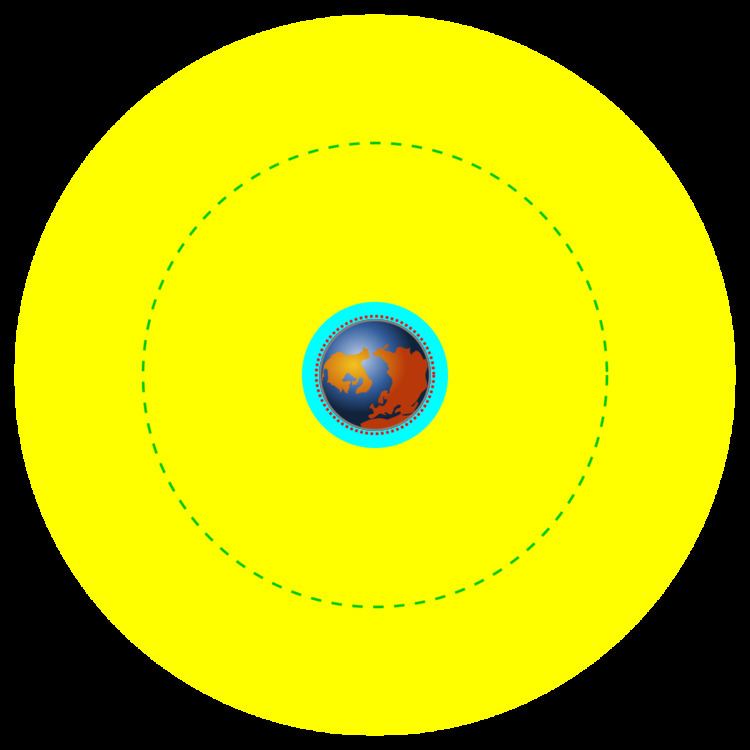 | ||
A geocentric orbit or Earth orbit involves any object orbiting the Earth, such as the Moon or artificial satellites. In 1997 NASA estimated there were approximately 2,465 artificial satellite payloads orbiting the Earth and 6,216 pieces of space debris as tracked by the Goddard Space Flight Center. Over 16,291 previously launched objects have decayed into the Earth's atmosphere.
Contents
List of terms and concepts
Geocentric orbit types
The following is a list of different geocentric orbit classifications.
Altitude classifications
Low Earth orbit (LEO) - Geocentric orbits ranging in altitude from 160 kilometers (100 statute miles) to 2,000 kilometres (1,200 mi) above mean sea level. At 160 km, one revolution takes approximately 90 minutes, and the circular orbital speed is 8,000 metres per second (26,000 ft/s).Medium Earth orbit (MEO) - Geocentric orbits with altitudes at apogee ranging between 2,000 kilometres (1,200 mi) and that of the geosynchronous orbit at 35,786 kilometres (22,236 mi).Geosynchronous orbit (GEO) - Geocentric circular orbit with an altitude of 35,786 kilometres (22,236 mi). The period of the orbit equals one sidereal day, coinciding with the rotation period of the Earth. The speed is approximately 3,000 metres per second (9,800 ft/s).High Earth orbit (HEO) - Geocentric orbits with altitudes at apogee higher than that of the geosynchronous orbit. A special case of high Earth orbit is the highly elliptical orbit, where altitude at perigee is less than 2,000 kilometres (1,200 mi).Inclination classifications
Inclined orbit - An orbit whose inclination in reference to the equatorial plane is not 0.Eccentricity classifications
Circular orbit - An orbit that has an eccentricity of 0 and whose path traces a circle.Elliptic orbit - An orbit with an eccentricity greater than 0 and less than 1 whose orbit traces the path of an ellipse.Hyperbolic trajectory - An "orbit" with eccentricity greater than 1. The object's velocity reaches some value in excess of the escape velocity, therefore it will escape the gravitational pull of the Earth and continue to travel infinitely with a velocity (relative to Earth) decelerating to some finite value, known as the hyperbolic excess velocity.Escape Trajectory - This trajectory must be used to launch an interplanetary probe away from Earth, because the excess over escape velocity is what changes its heliocentric orbit from that of Earth.Capture Trajectory - This is the mirror image of the escape trajectory; an object traveling with sufficient speed, not aimed directly at Earth, will move toward it and accelerate. In the absence of a decelerating engine impulse to put it into orbit, it will follow the escape trajectory after periapsis.Parabolic trajectory - An "orbit" with eccentricity exactly equal to 1. The object's velocity equals the escape velocity, therefore it will escape the gravitational pull of the Earth and continue to travel with a velocity (relative to Earth) decelerating to 0. A spacecraft launched from Earth with this velocity would travel some distance away from it, but follow it around the Sun in the same heliocentric orbit. It is possible, but not likely that an object approaching Earth could follow a parabolic capture trajectory, but speed and direction would have to be precise.Directional classifications
Prograde orbit - an orbit in which the projection of the object onto the equatorial plane revolves about the Earth in the same direction as the rotation of the Earth.Retrograde orbit - an orbit in which the projection of the object onto the equatorial plane revolves about the Earth in the direction opposite that of the rotation of the Earth.Geosynchronous classifications
Semi-synchronous orbit (SSO) - An orbit with an altitude of approximately 20,200 km (12,600 mi) and an orbital period of approximately 12 hoursGeosynchronous orbit (GEO) - Orbits with an altitude of approximately 35,786 km (22,236 mi). Such a satellite would trace an analemma (figure 8) in the sky.Special classifications
Sun-synchronous orbit - An orbit which combines altitude and inclination in such a way that the satellite passes over any given point of the planet's surface at the same local solar time. Such an orbit can place a satellite in constant sunlight and is useful for imaging, spy, and weather satellites.Moon orbit - The orbital characteristics of Earth's Moon. Average altitude of 384,403 kilometres (238,857 mi), elliptical–inclined orbit.Non-geocentric classifications
Horseshoe orbit - An orbit that appears to a ground observer to be orbiting a planet but is actually in co-orbit with it. See asteroids 3753 (Cruithne) and 2002 AA29.Exo-orbit - A maneuver where a spacecraft approaches the height of orbit but lacks the velocity to sustain it.References
Geocentric orbit Wikipedia(Text) CC BY-SA
